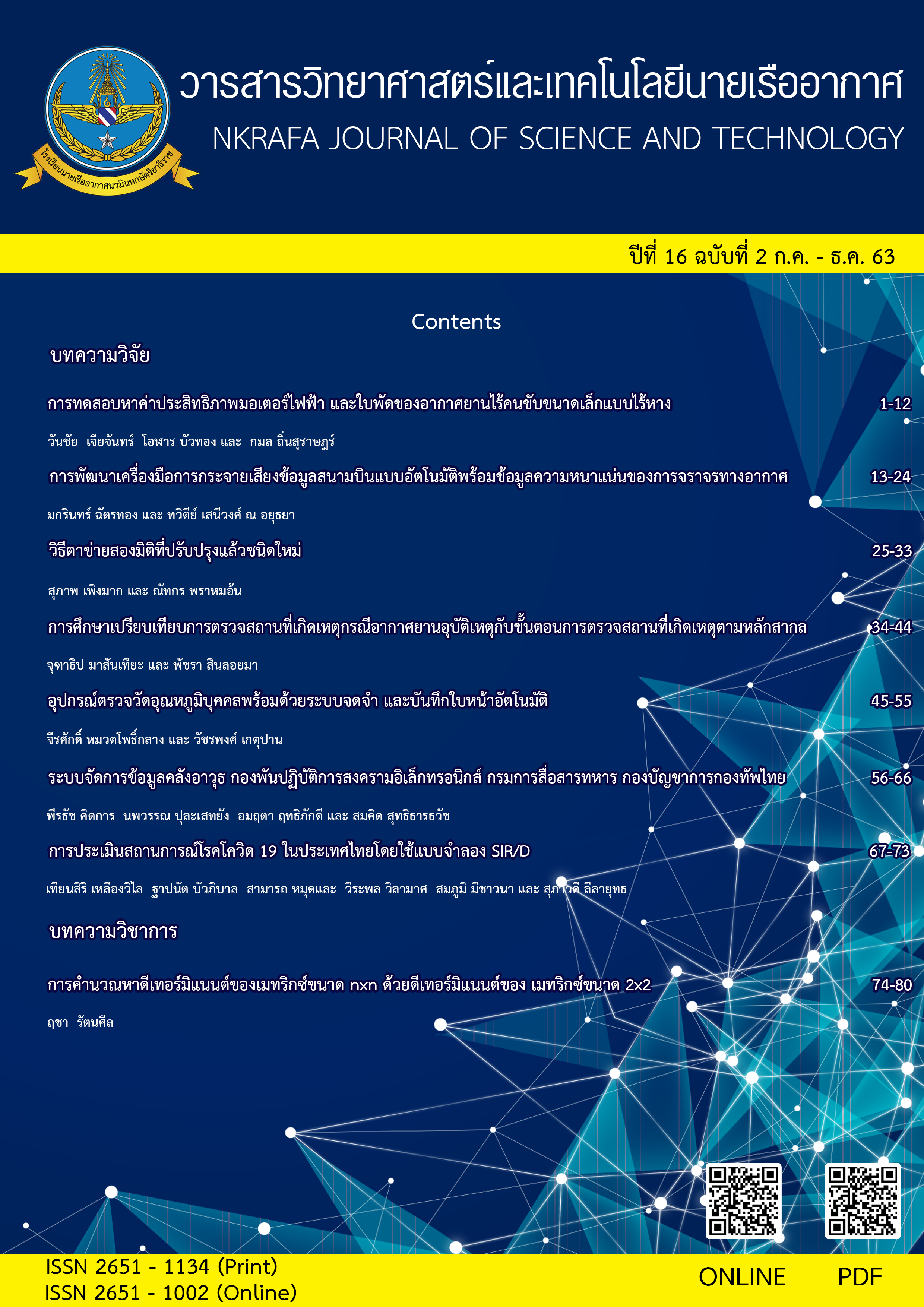Estimating the Covid-19 epidemic in Thailand by using SIR/D model
Main Article Content
Abstract
The Coronavirus or Covid-19 is currently one of the most fearful pathogens in modern human history. It not only courses the loss of lives around the world but also the biggest economic losses in recent years. In order to tackle this crisis, the prediction of epidemic situation becomes crucial. The objective of this study is to use the Susceptible-Infectious-Recovered-Dead or SIR/D model to estimate the Covid-19 situation in Thailand. The required parameters of SIR/D model are analysed and estimated by using real data of Covid-19 in Thailand until 4 April 2020.
Article Details

This work is licensed under a Creative Commons Attribution-NonCommercial-NoDerivatives 4.0 International License.
- Content and information in articles published in NKRAFA Journal of Science and Technology are comment and responsibility of authors of articles directly. Journal editorial do no need to agree or share any responsibility.
- NKRAFA Journal of Science and Technology Articles holds the copyright of the content, pictures, images etc. which published in it. If any person or agency require to reuse all or some part of articles, the permission must be obtained from the NKRAFA Journal of Science and Technology.
References
Biao T., Xia W., Qian L., Nicola L. B., Sanyi T., Yanni X., & Jianhong W.. (2020(a)). Estimation of the transmission risk of the 2019-ncov and its implication for public health interventions. Journal of Clinical Medicine, 9(2),
Biao T., Nicola L. B., Qian L., Sanyi T., Yanni X., & Jianhong W. (2020(b)). An updated estimation of the risk of transmission of the novel coronavirus (2019-ncov). Infectious Disease Modelling.
Hethcote, H.W. (2000). The Mathematics of Infectious Diseases, SIAM Review, 42(4), 599-653.
Holshue M. L., DeBolt C., Lindquist S., Lofy K. H., Wiesman J., Bruce H., et al. (2020). First Case of 2019 Novel Coronavirus in the United States. N Engl J Med.
Jonathan M. R., Jessica R. B., Derek A. C., Antonia H., & Chris P. J. (2020). Novel coronavirus 2019-ncov: early estimation of epidemiological parameters and epidemic predictions. medRxiv.
Kermack W. O. & McKendrick A. G. (1927). A Contribution to the Mathematical Theory of Epidemics. In Proceedings of the Royal Society A. 115 (772), 700-721.
Li Q., Guan X., Wu P., Wang X., Zhou L., Tong Y., et al. (2020) Early Transmission Dynamics in Wuhan, China, of Novel Coronavirus-Infected Pneumonia. N Engl J Med. DOI: 10.1056/NEJMoa2001316.
Munster V. J., Koopmans M., van Doremalen N., van Riel D., & de Wit E. (2020). A Novel Coronavirus Emerging in China - Key Questions for Impact Assessment. N Engl J Med.
Nesteruk, I. (2020). Statistics based predictions of coronavirus 2019-nCoV spreading in mainland China. medRxiv.
Rothe C., Schunk M., Sothmann P., Bretzel G., Froeschl G., Wallrauch C., et al. (2020). Transmission of 2019-nCoV Infection from an Asymptomatic Contact in Germany. N Engl J Med.
Tianmu C., Jia R., Qiupeng W., Zeyu Z., Jing-An C., & Ling Y. (2020). A mathematical model for simulating the transmission of Wuhan novel coronavirus. bioRxiv.
World Health Organization. (2020). Coronavirus Disease (COVID-19) Situation Dashboard. Retrieved 4th April 2020 from
https://experience.arcgis.com/experience/685d0ace521648f8a5beeeee1b9125c
Yan Y., Chen Y., Liu K., Luo X., Xu B., Jiang Y., & Cheng J. (2020). Modeling and prediction for the trend of outbreak of ncp based on a time-delay dynamic system. SCIENTIA SINICA Mathematica, 1674-7216.
Yu C., Jin C., Yu J., & Keji L. (2020). A time delay dynamical model for outbreak of 2019-ncov and the parameter identification. arXiv:2002.00418
Zhu N., Zhang D., Wang W., Li X., Yang B., Song J., et al. (2020). A Novel Coronavirus from Patients with Pneumonia in China, 2019. N Engl J Med. DOI: 10.1056/NEJMoa2001017


